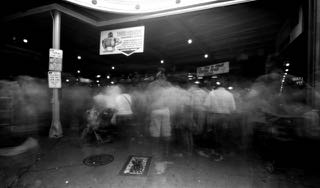A recurring component of pinhole photography is the long exposure time. Even out in bright sunlit skies we’ll often find the proper exposure to be 1 or 2 seconds. The result of course is that parts of your composition which are in motion – flags, people, trees in the wind, etc – will blur from the motion.
Seeing what the motion will do on the final photograph is part of the appeal of pinhole photography. Sometimes the results surpass our expectations. For example, this photo was taken at Cleveland’s West Side Market on a very busy Saturday at about noon. The place is so packed you can barely move! But you’d never know it from this 6 minute exposure. There’s barely a hint that a person is in that photo.
[singlepic id=25]West Side Market, ©Kier Selinsky 2015[/singlepic]
But what do we do if we don’t want people to completely disappear? Such was my challenge when I lived in Seattle and wanted to take some photos at the Pike Place Market (I have a thing for markets). The Pike Place Market is almost as packed as the West Side Market, but with the added bonus of flying fish. I wanted to clearly show the energy of the place, and that meant having some people. My solution? Multi-lapse.
[singlepic id=24]Pike Market 2, ©Kier Selinsky 2015[/singlepic]
In this photo, the total exposure was 15 seconds, which was long enough for the people to mostly disappear at the pace they were moving. Rather than leave the shutter open for 15 seconds and let them disappear, I took 3 exposures – each one for 5 seconds. You can see that there are some people who stayed still for 5 seconds at a time, and there are many who didn’t. The combined effect gives the energy and the presence to communicate the message I wanted!
Why does this work? Because film exposure is cumulative. In reality, this is a simple multi exposure – it just happens that each exposure is of the same scene! The application of it is simple:
- Meter the scene
- Determine the exposure (including any reciprocity considerations)
- Divide the exposure into several equal parts
- Make those smaller exposures in succession
Some different ways to apply the technique:
- Capturing many people
- Capturing a recurring occurrence (e.g. cars in the middle of an intersection)
- Controlling the light (e.g. if you metered for cloudy conditions and the clouds break mid-exposure, you can stop the exposure and wait for the clouds to return)
If you give this technique a try, let us know – we’d love to show your examples also!

Great to see pinhole photo technique sharing.